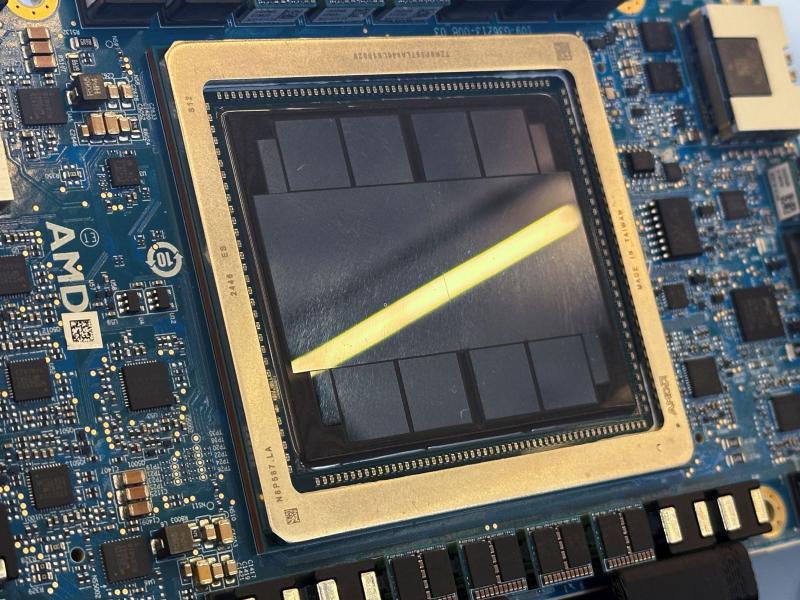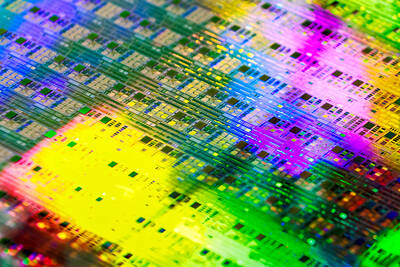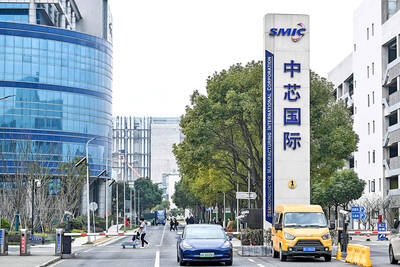Advanced Micro Devices Inc (AMD), the second-largest maker of artificial intelligence (AI) processors, said the chipmaker’s return to the crucial China market is difficult to predict, overshadowing a generally upbeat forecast for its AI business.
As part of its quarterly earnings report on Tuesday, AMD declined to predict Chinese sales of the Instinct MI308, an AI processor that the company designed for the Asian country. The uncertainty weighed on the shares, sending them down about 5 percent in extended trading.
The US President Donald Trump's administration had barred shipments of such chips to China in April, though it reversed course last month, raising hopes that AMD and rival Nvidia Corp could soon resume sales. China is the largest market for semiconductors, and the restrictions have threatened to erase billions of dollars in total revenue from both companies.

Photo: Max A. Cherney, Reuters
“As our licenses are still under review, we are not including any MI308 revenue in our third-quarter guidance,” AMD chief executive officer Lisa Su (蘇姿丰) said on a conference call with analysts.
Su was optimistic about the overall market for AI computing. “Looking ahead, we see a clear path to scaling our AI business to tens of billions of dollars in annual revenue,” she said during the call. The company also is ramping up its new MI350 lineup, she said.
AMD shares had gained 44 percent this year through the close, making AMD the best-performing stock in the semiconductor industry.
Three months ago, AMD said it was taking US$800 million in writedowns related to the Chinese export restrictions and warned that the curbs would cost it US$1.5 billion in revenue this year. Wall Street has been waiting for guidance on how that has changed, given the US policy shift.
On the conference call, analysts repeatedly asked for a specific outlook on how much China AI revenue the company will get and when. They also tried to get Su to commit to long-term predictions for overall AI chip revenue.
But Su and chief financial officer Jean Hu (胡錦) stuck to their message: While the executives are confident about the AI market, the specifics remain difficult to forecast. Earlier writedowns of Chinese inventory can’t be converted into revenue because they involved incomplete chips that will require further manufacturing work, they said.
Despite the uncertainties, AMD’s third-quarter revenue forecast easily cleared analysts’ estimates. The sales will be about US$8.7 billion, the company said, compared with an average projection of US$8.37 billion.
Second-quarter sales rose 32 percent year-on-year to US$7.7 billion, compared with a US$7.43 billion average estimate. Profit was US$0.48 a share, minus certain items. Analysts projected US$0.49. Data center sales gained 14 percent to US$3.2 billion in the period. On average, analysts had predicted US$3.25 billion. Personal computer-related sales climbed 67 percent to US$2.5 billion. The average prediction was US$2.56 billion.
AMD is the second-biggest provider of graphics chips, which form the basis for the AI accelerators that run in data centers. Its microprocessors, meanwhile, go head to head with Intel Corp products in the markets for PCs and servers.
AMD’s market capitalization is now roughly US$200 billion higher than Intel’s. Still, neither company has matched the runaway success of Nvidia, whose dominance of AI accelerators has made it the world’s most valuable business.

SEMICONDUCTOR SERVICES: A company executive said that Taiwanese firms must think about how to participate in global supply chains and lift their competitiveness Taiwan Semiconductor Manufacturing Co (TSMC, 台積電) yesterday said it expects to launch its first multifunctional service center in Pingtung County in the middle of 2027, in a bid to foster a resilient high-tech facility construction ecosystem. TSMC broached the idea of creating a center two or three years ago when it started building new manufacturing capacity in the US and Japan, the company said. The center, dubbed an “ecosystem park,” would assist local manufacturing facility construction partners to upgrade their capabilities and secure more deals from other global chipmakers such as Intel Corp, Micron Technology Inc and Infineon Technologies AG, TSMC said. It

NO BREAKTHROUGH? More substantial ‘deliverables,’ such as tariff reductions, would likely be saved for a meeting between Trump and Xi later this year, a trade expert said China launched two probes targeting the US semiconductor sector on Saturday ahead of talks between the two nations in Spain this week on trade, national security and the ownership of social media platform TikTok. China’s Ministry of Commerce announced an anti-dumping investigation into certain analog integrated circuits (ICs) imported from the US. The investigation is to target some commodity interface ICs and gate driver ICs, which are commonly made by US companies such as Texas Instruments Inc and ON Semiconductor Corp. The ministry also announced an anti-discrimination probe into US measures against China’s chip sector. US measures such as export curbs and tariffs

The US on Friday penalized two Chinese firms that acquired US chipmaking equipment for China’s top chipmaker, Semiconductor Manufacturing International Corp (SMIC, 中芯國際), including them among 32 entities that were added to the US Department of Commerce’s restricted trade list, a US government posting showed. Twenty-three of the 32 are in China. GMC Semiconductor Technology (Wuxi) Co (吉姆西半導體科技) and Jicun Semiconductor Technology (Shanghai) Co (吉存半導體科技) were placed on the list, formally known as the Entity List, for acquiring equipment for SMIC Northern Integrated Circuit Manufacturing (Beijing) Corp (中芯北方積體電路) and Semiconductor Manufacturing International (Beijing) Corp (中芯北京), the US Federal Register posting said. The

India’s ban of online money-based games could drive addicts to unregulated apps and offshore platforms that pose new financial and social risks, fantasy-sports gaming experts say. Indian Prime Minister Narendra Modi’s government banned real-money online games late last month, citing financial losses and addiction, leading to a shutdown of many apps offering paid fantasy cricket, rummy and poker games. “Many will move to offshore platforms, because of the addictive nature — they will find alternate means to get that dopamine hit,” said Viren Hemrajani, a Mumbai-based fantasy cricket analyst. “It [also] leads to fraud and scams, because everything is now